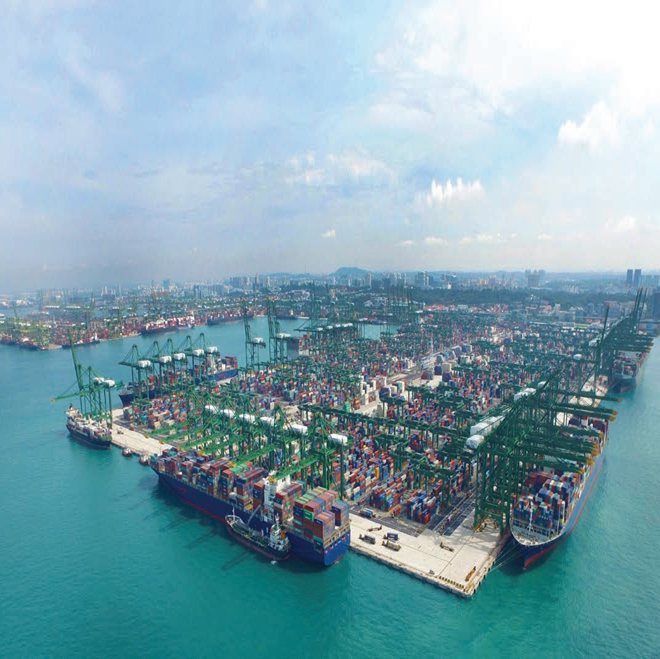《新加坡2050脱碳蓝图》港口篇
文件解读
发布者:KnowMi 发布时间: 2024-05-09 03:05:59 点击量: 2493 来源:KnowMi
新加坡港(新加坡港务集团PSAC运营)
中文概括:
新加坡港将通过集装箱搬运设备的优化以及运输车辆的电气化来实现港口绿色化。2015年起,新加坡港已经部署了自动化的轨道式集装箱起重机。同时,自2019年以来,新加坡港还使用了电气自动化设备来替换老的轮胎式柴油集装箱起重机。目前,这种燃烧柴油的集装箱起重机排放量约占新加坡港总体排放量的20%,根据计算,应用电气自动化设备后,将减少30%的起重机排放量。
另一方面,集装箱跨运车的排放量也占到了新加坡港总体排放量的20%。2021年,新加坡港启动了一个试点项目,引入了约160辆LNG集装箱跨运车,数量占现有车队的10%。同时,他们还将探索集装箱跨运车电动化的可能性。
总体而言,新加坡港目前已完成港口绿色化的第一阶段,未来还将部署全自动的船舶充电站等一系列港口全自动设施,同时,完成集装箱跨运车队向低碳或零碳动力的过渡。
英文原文:
PSAC aims to progressively electrify all diesel-based container handling equipment and vehicles at its container terminals. By phasing out combustion engines from container handling equipment and vehicles and switching to cleaner energy from the national power grid, PSAC will significantly reduce its direct emissions. PSAC has deployed electric-automated RMG cranes at its newer terminals since 2015. PSAC has also begun replacing its diesel RTG cranes at the older terminals (i.e. Terminals 1 to 3) with electric automated ones, since 2019. Currently, diesel RTG cranes account for about one-fifth of PSAC’s overall emissions, and the transition from diesel to electricity will reduce this figure by more than 30%. At present, prime movers account for around 40% of PSAC’s emissions. PSAC will progressively replace its fleet of older, diesel-operated prime movers that are powered by cleaner fuels, such as LNG. In mid-2021, PSAC embarked on a pilot project for 160 LNG-powered prime movers, representing about 10% of the fleet. PSAC is also exploring the adoption of electric prime movers from 2023.
PSAC is developing the future Tuas Port with sustainability as a key focus. The first phase of this multi-decade project involves deploying port infrastructure with full electric-automated rail mounted gantry cranes and electric AGVs to support automated terminal operations from 2021. Smart fast-charging stations will be built and centrally monitored by PSAC’s fleet management systems. By 2050, PSAC would have fully transited away from diesel fuel. Its container handling operations will be powered by electricity, supplemented by low or zero-carbon energy sources such as hydrogen.

裕廊港(裕廊海港有限公司JPPL运营)
中文概括:
裕廊港计划在2028年建立一个集中的钢材存储仓库。该仓库将与新加坡港一样采用电动集装箱起重机来替代柴油集装箱起重机,用于搬运钢材以及货物。
目前,裕廊港约有300辆柴油叉车用于货物的装卸作业,通过资源优化,将车队规模缩减30%,同时,在2026年之前分阶段引入清洁的替代材料,例如生物柴油,将减少15%-20%来自叉车的排放。
英文原文:
JPPL has plans to establish a centralised inventory yard for steel storage by 2028, which will utilise electric overhead gantry cranes in place of diesel-powered forklifts, for the handling of steel cargo. Such innovations will enable JPPL to reap greater economies of scale and improve energy efficiency in cargo handling. JPPL will work with the larger port community to 'green' operations, beyond JPPL’s existing direct and indirect emissions. At present, there are around 300 diesel forklifts being used within Jurong Port for cargo handling operations that are owned by individual stevedoring companies. JPPL has started to consolidate and centrally manage this fleet of forklifts, which is expected to reduce the fleet size by approximately 30% through resource optimisation.
JPPL will also introduce cleaner alternative fuels in phases by 2026, such as biodiesel, to power its forklift fleet.
This switch to cleaner energy sources is estimated to achieve approximately 15-20% reduction in emissions as compared to traditional diesel.

更清洁的目标
Reducing emissions from electricity
两港还会与电力公司合作,使用绿色电力,减少其港口以及装卸设备的间接排放。从2025年起,将逐步采购绿色电力:
As part of Singapore’s energy transition plan, the power sector will harness the four Switches – natural gas, renewable energy, electricity imports and low-carbon alternatives (such as hydrogen and CCSU) to decarbonise the grid. This will enable port operators to reduce their indirect emissions from electric-powered port handling equipment and vehicles.
To this end, PSAC and JPPL are actively collaborating with industry partners and power generation companies to improve their grid emission factor and source green electricity imported from regional grid. From 2025 onwards, PSAC will progressively source for green electricity, subject to economic considerations and availability.
JPPL will also use green electricity when commercially viable. In line with the Singapore government’s long-term plan to import 30% of electricity from low-carbon sources, JPPL may tap on existing green electricity within the grid, either generated locally or overseas.